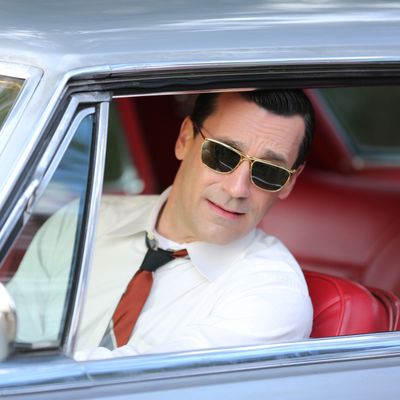
The new poster for the final batch of Mad Men episodes is here, and it features a determined-looking Don Draper driving off into (well, out of) the sunset. Matthew Weiner was predictably cagey about the exact meaning of the image, but he did tell Vulture that ÔÇ£thereÔÇÖs going to be a sense of motionÔÇØ to the final chapter. Mad MenÔÇÖs a show that wrestles with the fundamental idea of change ÔÇö┬áwhether people change, what happens to us when times change, whoÔÇÖs responsible for resisting or inciting change. That ambivalence is reflected over and over again in MMÔÇÖs odd relationship with transportation: car crashes, plane crashes, identity crises on trains. If youÔÇÖre a character on Mad Men, for the love of God, stay put.
Season 1
We first see Don in a car at the tail end of the pilot, just before the surprise reveal that heÔÇÖs actually a married dad and Midge is his mistress, not his girlfriend. The pilot actually makes a point of showing Don on the train and in the car, going away, away, away from Manhattan. When we see Don on a train in general, we know something is up: We next see him on a train in episode three, where an old acquaintance recognizes him as ÔÇ£old Dick Whitman.ÔÇØ DonÔÇÖs stunned. So stunned, in fact, that later in the episode he drives aimlessly with SallyÔÇÖs birthday cake, shirking his responsibilities and drunkenly parking himself at the train station instead of returning to her party. (Away, away, away.) In episode 12, we see in flashback our Don on a train along with the coffin of the actual Don, ignoring a young Adam, who swears he spotted his big brother. We see DonÔÇÖs commute one last time in season one in episode 13, with Don trudging home, daydreaming that his family will be there waiting for him. They are not.
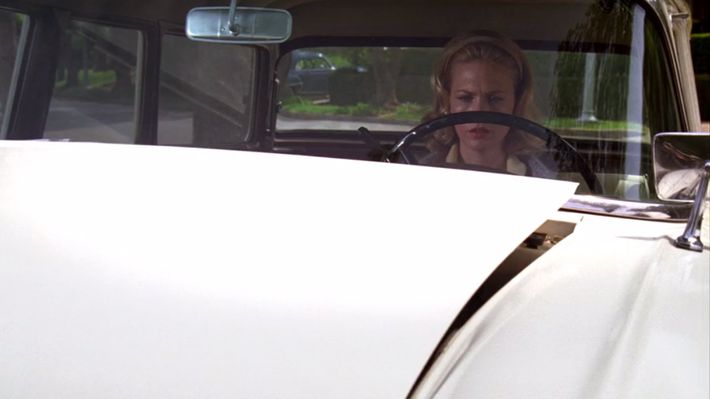
DonÔÇÖs not the only one who should stick to walking. Betty has terrible car juju: In episode 2, she gets carsick, and then later crashes her car during a sort-of panic attack. In the season finale, she approaches Glen, whoÔÇÖs sitting in his motherÔÇÖs parked car. They hold hands briefly through the window.
Season 2
EveryoneÔÇÖs car troubles continue in season two. In the season premiere ÔÇ£For Those Who Think Young,ÔÇØ BettyÔÇÖs car breaks down, and she attempts to flirt with the mechanic to lower the cost of repairs; it turns extremely shady for a hot second, and Betty finds the moment both erotic and scary (which is how she finds a lot of moments). In ÔÇ£The Benefactor,ÔÇØ Betty and Don have dinner with Bobbi and Jimmy Barrett, and Betty cries in the car on the way home, even though sheÔÇÖs not fully aware of Don and BobbiÔÇÖs affair just yet. Which is too bad, since the affair puts those two in legit danger when Don drunkenly crashes his car in ÔÇ£The New Girl.ÔÇØ (Peggy has to pick Don and Bobbi up at a faraway police station. She diligently drives them back to the city.)

That crash might have been the worst of things if not for ÔÇ£The Gold Violin.ÔÇØ In that episode, we learn in flashback that Don was once a car salesman ÔÇö and in fact, Anna Draper tracked him down at a dealership. Don decides to treat himself and Betty to a new car, and sheÔÇÖs thrilled when he presents it to her. But it doesnÔÇÖt take long for something to go awry, and by the end of the episode, she pukes, right in the front seat.
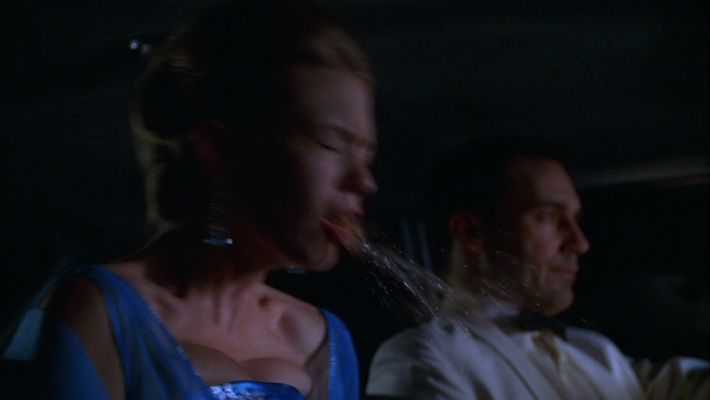
Don has a few other car scenes in season two: He jumps in the car with the spacey, alluring Joy in California, ditching all his meetings and confusing everyone he leaves behind. He takes a bus to see Anna, and in ÔÇ£The Mountain King,ÔÇØ tells a group of guys tinkering with hot rods heÔÇÖs looking for work. HeÔÇÖs not, or not really, but itÔÇÖs not clear to whom heÔÇÖs lying: those guys? Us? Himself? Everyone all the time?
Season two has two other major transportation moments: In ÔÇ£Flight 1,ÔÇØ Pete learns that his father has died in a plane crash. ThereÔÇÖs a significant amour of airline talk at Sterling Cooper ÔÇö about Mohawk in particular, but they also work on American, and chat about air travel frequently ÔÇö so of course PeteÔÇÖs topsy-turvy about how to present himself professionally in the wake of his fatherÔÇÖs death. (He mentions it in a pitch, which does not go over well.) Beyond PeteÔÇÖs literal reaction, though, thereÔÇÖs something very abstract about a plane crash, especially as portrayed here: Pete et al. learn of the crash on the radio, and people are already making jokes and being crass by the time he gets a phone call telling him his father was on the flight. We see people die on Mad Men not constantly, but at least a few times, and if the show for some reason had wanted to do a ÔÇ£Pete sits vigil at his fatherÔÇÖs deathbedÔÇØ kind of story, that wouldnÔÇÖt be so impossible. Instead, thereÔÇÖs something more unpredictable, ominous, and alien about a plane crash, baffling and closure-proof.
We see one other notable car scene in season two, though itÔÇÖs a parked car, so the danger of the enterprise feels less imminent. ItÔÇÖs in the fourth episode, ÔÇ£Three Sundays,ÔÇØ and Father Gil has driven Peggy to the subway station. They sit for a moment, and he asks for some advice delivering his first Palm Sunday homily. ItÔÇÖs an odd moment for Peggy, whoÔÇÖs still struggling to get everyone at Sterling Cooper to give her even a shred of the respect she deserves. SheÔÇÖs the odd woman out in her family, and sheÔÇÖs pretty clearly not into church. But Father Gil likes and admires her, and his genuine plea for assistance in this moment winds up being a turning point for Peggy. In this episode, itÔÇÖs still not clear exactly what the deal is with PeggyÔÇÖs baby ÔÇö┬ámaybe heÔÇÖs being raised as her nephew? But in the following episode, as Peggy dutifully assists Don and Bobbi Barrett, itÔÇÖs like sheÔÇÖs finally comfortable enough in her new self to acknowledge (to us in the audience, but to herself, too) what happened at the end of season one. Her nephewÔÇÖs her nephew; her child was placed for adoption. Clarity!
Season 3
Season three practically opens on a plane: Don and Sal are traveling to Baltimore, and they flirt with the flight attendants. Well, Don does, and Sal plays along. Later at their hotel, Sal is accidentally outed when a fire alarm goes off and everyone flees. On the flight back, Sal briefly panics when Don asks for a moment of real honesty ÔÇö but itÔÇÖs about a possible slogan, not SalÔÇÖs closeted sex life. ÔÇ£Limit your exposure,ÔÇØ indeed.
ItÔÇÖs not that only bad moments happen in transit; itÔÇÖs more that many pivotal moments do. In season threeÔÇÖs ÔÇ£The Arrangements,ÔÇØ Grandpa Gene recklessly lets Sally drive his car. ItÔÇÖs a dumb idea, yeah, but itÔÇÖs probably the highlight of her life, and while Grandpa GeneÔÇÖs seems like the turning point in SallyÔÇÖs childhood, it might actually be taking the wheel while her brother jealously whines in the back. This is the first time an adult has trusted and encouraged Sally. Grandpa Gene actually likes Sally, and thatÔÇÖs a big shift for her, away from two parents who have so much of their own baggage they can barely remember to feed her dinner.
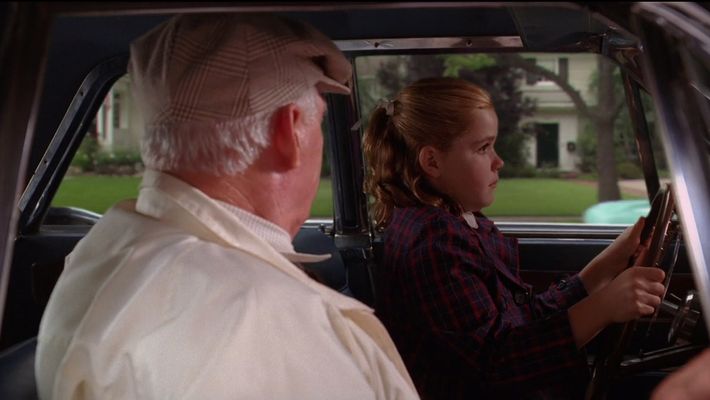
A lawnmower isnÔÇÖt really a mode of transportation, but: the lawnmower. ÔÇ£Guy Walks Into an Advertising AgencyÔÇØ is set several months before the Kennedy assassination, but for Mad Men, this is really when the cultural entropy starts in earnest. The following episode has Don getting jumped by the hitchhikers he picks up; it finds Betty beginning her romance with Henry Francis in earnest; somehow Duck seduces Peggy. ThatÔÇÖs all in one episode! The wheels have come off the wagon. Well, the foot has come off the British guy, at least. Things are getting tense.
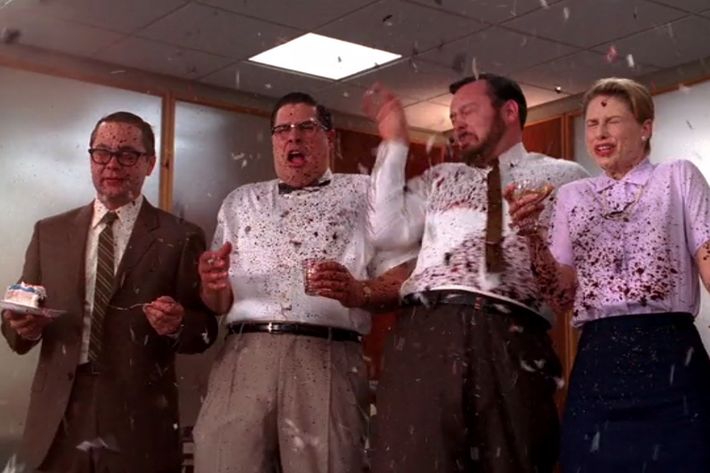
In ÔÇ£Wee Small Hours,ÔÇØ we see Don in his car again, this time with Miss Farrell; the two listen to a radio broadcast of the ÔÇ£I Have a DreamÔÇØ speech. Don later drives by that same spot, hoping to accidentally-on-purpose run into her again. In ÔÇ£The Color Blue,ÔÇØ DonÔÇÖs train ride again becomes a neither-here-nor-there place: Suzanne gets on the train to surprise him and have a conversation, which is both clandestine and completely public. She convinces Don to drive her brother somewhere and he agrees, only to later drop said brother elsewhere, per brotherÔÇÖs request. At the end of the episode, several characters have here-but-not-here moments in the back of their respective cars: RogerÔÇÖs mother mistakes Jane for Margaret; LaneÔÇÖs wife is thrilled but Lane is crushed that they might move back to England; Betty rides with Don without telling him that sheÔÇÖs discovered his secret locked drawer. She doesnÔÇÖt confront him until ÔÇ£The Gypsy and the HoboÔÇØ ÔÇö a confrontation that happens while Suzanne is outside sitting in DonÔÇÖs car.
JFK gets shot. While in a car.
And finally, how do we know for sure that Betty and Henry Francis are going to wind up together? We see them, on a plane, en route to Reno.
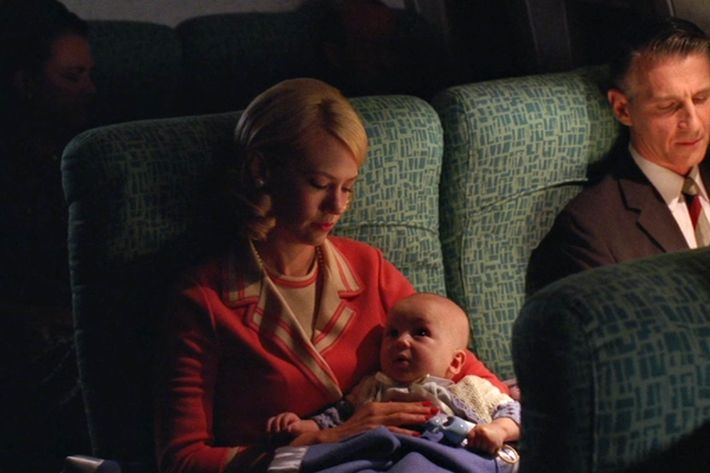
Season 4
Our first car scene is in the season premiere, ÔÇ£Public Relations.ÔÇØ Don and his date Bethany are noodling around in the back of the cab, and she politely and genuinely declines to take things further. We see the flip of this with Betty and Henry, hooking up in their car while itÔÇÖs parked in the garage. Ah, bench seats. The couples are presented again in car-by-car make-outs later in the season in ÔÇ£The Summer Man,ÔÇØ this time with Betty and Henry fighting bitterly, while Bethany goes down on Don in the back of the cab. To everything there is a season. Don hooks up in yet another cab later in that episode, this time with Dr. Faye; notably, heÔÇÖs the one who decides to take things slow in that instance, because he seems so taken by her.
Don visits California again in ÔÇ£The Good News,ÔÇØ and we see him on a plane, which is the kind of filler shot Mad Men wouldnÔÇÖt bother with unless it meant something ÔÇö┬áwe know how people get from New York to California. But plane travel on the show lets people reestablish identity. As he heads to California, Don decides to be Dick, of course. He even rents a red convertible, though maybe that turns him back into Don, since he scams on AnnaÔÇÖs college-age niece while driving her home. The transformation back into full Don is completed on the plane ride home, which occurs on New YearÔÇÖs Eve. WhatÔÇÖs your resolution, Don?
Transit moments in season four are often about negotiation, which becomes codified in ÔÇ£The Chrysanthemum and the Sword,ÔÇØ an episode about negotiating (or not) with Honda that uses a sporty motorcycle as part of the mind games against Cutler Gleason and Chaough. Around and around and around Peggy rides, just on a soundstage, not doing anything or going anywhere, except itÔÇÖs Peggy ÔÇö sheÔÇÖs always going somewhere.
Joan has a moment of self-negotiation in ÔÇ£Hands and Knees.ÔÇØ SheÔÇÖd gone to Morristown to have an abortion, but after a jarring encounter in the waiting room, where another woman assumed Joan was the mother of a teenager, she changed her mind. ItÔÇÖs not clear in the moment that she did, but we learn later she did not have the abortion, so the scene of her on the bus is a quick glimpse of how sheÔÇÖs telling herself the story of what just happened. SheÔÇÖs sitting there by herself, just like she went by herself to that doctor, just like sheÔÇÖs going to raise her baby more or less by herself, since sheÔÇÖs married to such a dipshit, and she canÔÇÖt exactly run off with Roger. ItÔÇÖs a brief scene, but in that quick shot we can see Joan decide how she wants to be: SheÔÇÖs sad and scared for a second, and then excited, determined, a little bit happy.
Peggy, too, is happy, in the back of Joyces car, sitting on Abes lap in Chinese Wall. Bettys pretty unhappy when she drives up and catches Sally hanging out with Glen Bishop in Blowing Smoke. Is this me? they both wonder. For Peggy, the answers a giddy, vaguely horny yes  yes, shes into a romance; yes, shes into left-wingers. For Betty, the answers a lot less clear: Bettys jealous of Sally, which is something shes unable to acknowledge or understand; shes on the one hand proud of herself because she sees this as an instance of appropriate mothering, but shes also frustrated because well, why is Sally like this in the first place? (Oy, Betty.)
Season 5
So weÔÇÖve seen crisis, alienation, maturation, and negotiation. Season fiveÔÇÖs transit attitudes ÔÇö and season five, generally speaking ÔÇö┬áare about identity. It starts early, with Lane finding someoneÔÇÖs wallet in a cab. He becomes intrigued by a photo of a woman in the wallet, because everything in LaneÔÇÖs life is feeling particularly difficult. Don purposefully leaves GinsbergÔÇÖs drawing in a cab in ÔÇ£Dark Shadows,ÔÇØ as a way of reaffirming his place atop the idea pyramid. ThereÔÇÖs more identity revealing in ÔÇ£Tea Leaves,ÔÇØ when a stoned Harry Crane reveals ÔÇö by housing a bag of burgers ÔÇö just how immature he is. (This, moments after Don and Harry mistake another group of guys for the Rolling Stones.)
In ÔÇ£Signal 30,ÔÇØ PeteÔÇÖs in a driverÔÇÖs ed class ÔÇö if thereÔÇÖs anyone who needs to learn about having an identity, itÔÇÖs Captain Weaselthoughts, who could use a new one. (This is the episode where Lane smacks him.) Don is trying so hard to be the father and husband he never was before, and in the car with Megan, on the way home from a torturous dinner party at PeteÔÇÖs, Don pulls over and asks to ÔÇ£make a baby.ÔÇØ Change does not come easy, but maybe just for this moment, this car ride, this one sex act, Don can actually be who he thinks heÔÇÖs trying to be. Because in ÔÇ£Far Away Places,ÔÇØ he tries to construct MeganÔÇÖs identity for her, too, which sheÔÇÖs not interested in. They can drive away, he tells her; sheÔÇÖs the bossÔÇÖs wife! IsnÔÇÖt that great? SheÔÇÖs unmoved, and she falls asleep. Later, they have a huge fight at Howard JohnsonÔÇÖs, and Don drives off in a huff, leaving Megan behind. Is that who he is instead?
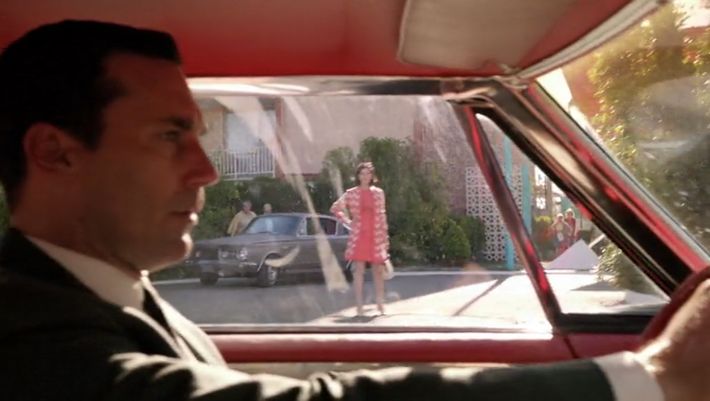
The second half of season five gets to the grittier, more shameful sides of identity. In ÔÇ£Lady Lazarus,ÔÇØ Pete becomes his worst self in transit. He can be a real piece of work at the office, but his behavior here is even more devious and cruel. On the train, he bumps into an acquaintance, Howard, who brags that heÔÇÖs got a mistress in the city. Pete winds up seducing that guyÔÇÖs tragic wife, Beth, by driving her home. They have sex, and then Pete gets back in his car, trying to transition from ÔÇ£guy who cheats on his wife with a very unstable womanÔÇØ to ÔÇ£guy who just goes home.ÔÇØ Back on the train, Pete wrangles a dinner invite to Howard and BethÔÇÖs, so unable is he to see himself and his actions clearly. One night at the train station, Pete sees Beth, and she draws a heart on her car window. We see Pete and Howard on the train together a few more times, each as rotten as the last. They get in a fistfight on the train in ÔÇ£The Phantom,ÔÇØ because Pete sees himself as BethÔÇÖs gallant protector. (He is wrong.)
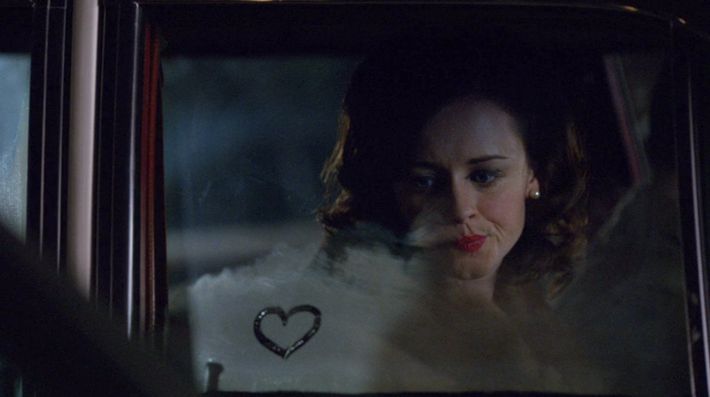
Speaking of rotten, remember Jaguar? Don and Joan are at a Jaguar dealership in ÔÇ£Christmas Waltz,ÔÇØ pretending ÔÇö┬áeasily ÔÇö to be a married couple considering a car purchase. Don pays off the salesman so he and Joan can take a test drive just the two of them, and itÔÇÖs the ominous start of JoanÔÇÖs performances for Jaguar-related purposes. All things Jaguar wind up being more or less poisonous for the rest of the season: Rebecca Pryce buys a Jaguar in ÔÇ£Commissions and Fees,ÔÇØ and that becomes LaneÔÇÖs breaking point. He tries to kill himself with that car, and when that doesnÔÇÖt work, he goes to the office and kills himself there. ThereÔÇÖs a part of Don that blames himself, and thatÔÇÖs the part that offers to drive Glen Bishop back to Connecticut, and then to let Glen take the wheel for a bit. In this car, Don is the kind of guy who grants wishes. He makes people happy. He encourages people to joyfully enjoy control of their own lives. That feels good, that feels right, that feels like a thing Don wants to do and be. But it doesnÔÇÖt last. Nothing does.
Season 6
In season six, that inability to last is a failure, and we see instance after instance of shortcomings, even tragedy, tied to vehicles. It starts with Betty getting a ticket in ÔÇ£The Doorway,ÔÇØ relatively minor until her mother-in-law tries to pull strings. In ÔÇ£To Have and to Hold,ÔÇØ Joan rides in a cab with her old friend Kate and some skeezy dude who kisses them both, which is not inherently mangy but certainly is here. DonÔÇÖt do it, Joan! Don and Megan, also in a cab, joke about the couple who wanted to swing with them, but as Don laughs along, heÔÇÖs also massively lying. HeÔÇÖs cheating on Megan, and we know he is, and while sheÔÇÖs finding this exchange hilarious and endearing, we know itÔÇÖs the beginning of the end. ItÔÇÖs a failure, this conversation. This marriage.
Ted Chaough┬áflies his own plane in ÔÇ£Man With a Plan,ÔÇØ and while itÔÇÖs a success for Ted, itÔÇÖs another knock against Don, whose apprehension and queasiness give Ted the upper hand. DonÔÇÖs the guy whose virility makes everyone feel safe and protected ÔÇö until now, when suddenly heÔÇÖs the guy sweating and kind of freaking out. Then comes ÔÇ£The Crash,ÔÇØ where Ken loses an eye. And everyone hates the car Harry rents in ÔÇ£A Tale of Two Cities.ÔÇØ Stupid Harry.

ÔÇ£The Quality of MercyÔÇØ gives us precise shortcomings from both Sally and Betty. As Betty tries to be enthusiastic about sending Sally to a very fancy boarding school, SallyÔÇÖs surly and pouty even though sheÔÇÖs getting what she says she wants ÔÇö which is to be away from Betty. BettyÔÇÖs not a good mother for a number of reasons, and on the ride back from the school visit, thatÔÇÖs brought into relief: She raised Sally to be just like she is, which is basically a tragedy. She lets Sally have a cigarette, which is bad, too, though not as bad as raising someone who doesnÔÇÖt know what healthy love feels like.
The transit failures start piling up in even sillier fashion. PeteÔÇÖs mother allegedly falls overboard while on a cruise. Pete wrecks a car in a showroom for Chevy, the client theyÔÇÖve been wooing so ardently. Don drives his kids to see the rickety brothel where he grew up, because that seems like a really stable thing to do. Crash, crash, crash.
Season 7
Change is bad, and change is inevitable. WeÔÇÖre not who we think we are, but weÔÇÖre trying. Be yourself, but God, please be a better version of it. The first half of season seven uses transit as a measure of will: How far will we go? In ÔÇ£Time Zones,ÔÇØ Don flies back and forth, a lot, to California. So often that heÔÇÖs literally in the passenger seat with Megan picking him up from the airport. ThatÔÇÖs a far reach for our Don. Even farther, though, is the end of his car ride with Sally in ÔÇ£A DayÔÇÖs Work.ÔÇØ After a pretty rough weekend, Don drops Sally off back at school, and without any pretense, she looks right at him and says, ÔÇ£Happy ValentineÔÇÖs Day. I love you.ÔÇØ ThatÔÇÖs a stretch for both of them ÔÇö maybe not to feel it, but certainly to say it. Ted is in such a state of despair that he cuts the engine on his plane just for a moment, but enough to scare the crap out of his Sunkist passengers.
How far will we go? To the moon and back, ÔÇ£WaterlooÔÇØ reminds us. The value of human endeavor lies in the actual endeavoring. Don and Peggy and Pete and Ted, Sally and Betty and Roger and Harry, Joan and Dawn and Bert: WeÔÇÖve seen everyone have a moment where they think,┬áWhy am I even trying? And on their trains and buses and cars and motorcycles and rocketships and planes, the answer is because I have somewhere to go.

